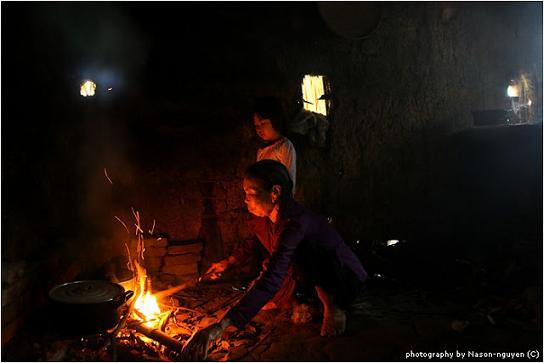21 January, 2016 | Friday, 27/02/2015 | 11:29 AM
The envoy Margie Mason of AP news agency made a reportage from Hanoi (in 2007), showing that Vietnam involves in a threat to which is not paid enough attention in Asia: that is indoor air pollution from cooking with wood, coal and cheap fuels leading to awful consequences.
Indoor air pollution from cooking
Having no chimney has made many kitchens smoky from ceiling down to walls. Human lungs received no exception. Kitchen smoke is the cause of so many diseases, from lung cancer to cataract and many other diseases in respiratory apparatus. Regrettably, people died or infectious from indoor air pollution are environment patients falling into oblivion. More than 3 billion people in the world still have to cook with wood, coal, cow dung, straws, and other cheap fuels creating much toxic smoke, ranking the forth bad impact on human health in poor countries.
According to the World Health Organization (WHO), toxic smoke from cook stoves is one of 5 leading threats to people health in developing countries, resulting in early death of nearly 4 million people all over the world every year, of which women and children are affected the most. In Asia, Afghanistan, Pakistan, Bangladesh, India and Laos are countries with the most people died from indoor air pollution with over 500,000 deaths per year. In India, many houses create emitting smoke volume at 40 times higher than what permitted by WHO. Such volume is even much higher during cooking time. Mothers and children are affected the most as they often live indoor. Many mothers even hold children in their arms during cooking, exposing those children’s lungs to smoke.
The poor who has to live in limited living conditions and use crude and cheap fuels is the first victim of indoor pollution. They are not conditional to clean fuels or systems for disposing or filtering waste air. But even living in countryside with broad space for cooking, the poor also often cook indoor for a convenient lifestyle. As calculated by experts, in 100 coming years, the world will continue witnessing deaths from indoor pollution. “Many people have no idea that they are living together with indoor exhausting air, and the danger of which may be 10 times higher than smoke and dust outdoor in streets or roads.” – said Eva Rehfuess, expert of Partnership for Clean Indoor Air under the World Health Organization (WHO). Even WHO is also surprise at the large-scale damage of the issue.

Smoky kitchen is the killer to millions of women and children every year
Recently, the magazine Lancet has issued a series of articles on the relation between health and energy use, in which, they highlighted on the possibility to decrease indoor exhausting air for 50% by using cook stoves with proper smoke disposing pillars. In 2002, WHO researched deeply on indoor pollution for the first time. The World Health Report ranked the danger of indoor exhausting smoke to human health only after dirty water and poor hygiene, being the biggest environment threats in developing countries. The report showed that, indoor pollution from cooking may be 10 times higher than pollution levels in the most pollutant cities around the world. In 2002, it’s estimated that nearly 2/3 of deaths in Asia Pacific region were related to the use of solid fuels for cooking.
Furthermore, the use of wood, charcoal, straw and rice husks as firing fuels also increased forest devastation, caused decrease in living environment, increased pressure on natural resources of localities. Inefficient cook stoves also caused more increase in climate change as they emit into environment with black carbon and green house airs like CO2 and methane.